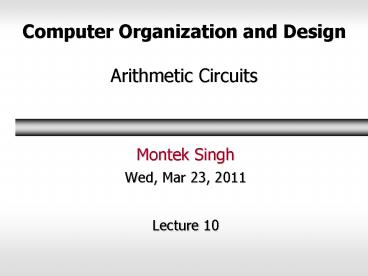Computer Organization and Design Arithmetic Circuits - PowerPoint PPT Presentation
Title:
Computer Organization and Design Arithmetic Circuits
Description:
Arithmetic Circuits 01011 +00101 10000 Didn t I learn how to do addition in the second ... CI to CO CIN-1 to SN-1 (N) is read order N and tells us that ... – PowerPoint PPT presentation
Number of Views:114
Avg rating:3.0/5.0
Title: Computer Organization and Design Arithmetic Circuits
1
Computer Organization and DesignArithmetic
Circuits
- Montek Singh
- Wed, Mar 23, 2011
- Lecture 10
2
Arithmetic Circuits
Didnt I learn how to do addition in the second
grade?
010110010110000
Finally time to build some serious functional
blocks
Well need a lot of boxes
3
Review 2s Complement
N bits
20
21
22
23
2N-2
-2N-1
Range 2N-1 to 2N-1 1
sign bit
binary point
- 8-bit 2s complement example
- 11010110 128 64 16 4 2 42
- Beauty of 2s complement representation
- same binary addition procedure will work for
adding both signed and unsigned numbers - as long as the leftmost carry out is properly
handled/ignored - Insert a binary point to represent fractions
too - 1101.0110 8 4 1 0.25 0.125 2.625
4
Binary Addition
- Example of binary addition by hand
- Lets design a circuit to do it!
- Start by building a block that adds one column
- called a full adder (FA)
- Then cascade them to add two numbers of any size
A 1101B 0101 10010
5
Designing an Adder
- Follow the step-by-step method
- Start with a truth table
- Write down eqns for the 1 outputs
- Simplifying a bit (seems hard, but experienced
designers are good at this art!)
6
For Those Who Prefer Logic Diagrams
- A little tricky, but only 5 gates/bit!
7
Subtraction A-B A (-B)
- Subtract B from A add 2s complement of B to A
- In 2s complement B B 1
- Lets build an arithmetic unit that does both add
and sub - operation selected by control input
8
Condition Codes
- One often wants 4 other bits of information from
an arith unit - Z (zero) result is 0
- big NOR gate
- N (negative) result is lt 0
- SN-1
- C (carry) indicates that most significant
position produced a carry, e.g., 1 (-1) - Carry from last FA
- V (overflow) indicates answer doesnt fit
- precisely
To compare A and B, perform AB and
use condition codes Signed comparison LT N?V
LE Z(N?V) EQ Z NE Z GE (N?V)
GT (Z(N?V)) Unsigned comparison LTU C
LEU CZ GEU C GTU (CZ)
9
TPD of Ripple-Carry Adder
(What is TPD?? See Lec. 8-9)
An-1 Bn-1 An-2 Bn-2 A2
B2 A1 B1 A0 B0
C
Sn-1 Sn-2
S2 S1 S0
Worse-case path carry propagation from LSB to
MSB, e.g., when adding 11111 to 00001. tPD
(tPD,XOR tPD,AND tPD,OR) (N-2)(tPD,OR
tPD,AND) tPD,XOR ? ?(N)
?(N) is read order N and tells us that the
latency of our adder grows in proportion to the
number of bits in the operands.
10
Can we add faster?
- Yes, there are many sophisticated designs that
are faster - Carry-Lookahead Adders (CLA)
- Carry-Skip Adders
- Carry-Select Adders
11
Adder Summary
- Adding is not only common, but it is also tends
to be one of the most time-critical of operations - As a result, a wide range of adder architectures
have been developed that allow a designer to
tradeoff complexity (in terms of the number of
gates) for performance.
Smaller / Slower
Bigger / Faster
RippleCarry
Carry Skip
Carry Select
Carry Lookahead
At this point well define a high-level
functional unit for an adder, and specify the
details of the implementation as necessary.
sub
12
Shifting Logic
- Shifting is a common operation
- applied to groups of bits
- used for alignment
- used for short cut arithmetic operations
- X ltlt 1 is often the same as 2X
- X gtgt 1 can be the same as X/2
- For example
- X 2010 000101002
- Left Shift
- (X ltlt 1) 001010002 4010
- Right Shift
- (X gtgt 1) 000010102 1010
- Signed or Arithmetic Right Shift
- (-X gtgtgt 1) (111011002 gtgtgt 1) 111101102
-1010
13
Boolean Operations
- It will also be useful to perform logical
operations on groups of bits. Which ones? - ANDing is useful for masking off groups of
bits. - ex. 10101110 00001111 00001110 (mask
selects last 4 bits) - ANDing is also useful for clearing groups of
bits. - ex. 10101110 00001111 00001110 (0s clear
first 4 bits) - ORing is useful for setting groups of bits.
- ex. 10101110 00001111 10101111 (1s set
last 4 bits) - XORing is useful for complementing groups of
bits. - ex. 10101110 00001111 10100001 (1s invert
last 4 bits) - NORing is useful for.. uhm
- ex. 10101110 00001111 01010000 (0s invert,
1s clear)
14
Boolean Unit
- It is simple to build up a Boolean unit using
primitive gates and a mux to select the function. - Since there is no interconnectionbetween bits,
this unit canbe simply replicated at
eachposition. - The cost is about7 gates per bit. One for each
primitive function,and approx 3 for the 4-input
mux. - This is a straightforward, but not too elegant of
a design.
15
An ALU, at Last
- Now were ready for a big one!
- An Arithmetic Logic Unit!
Thats a lot of stuff
FlagsV,C
N Flag
Z Flag

